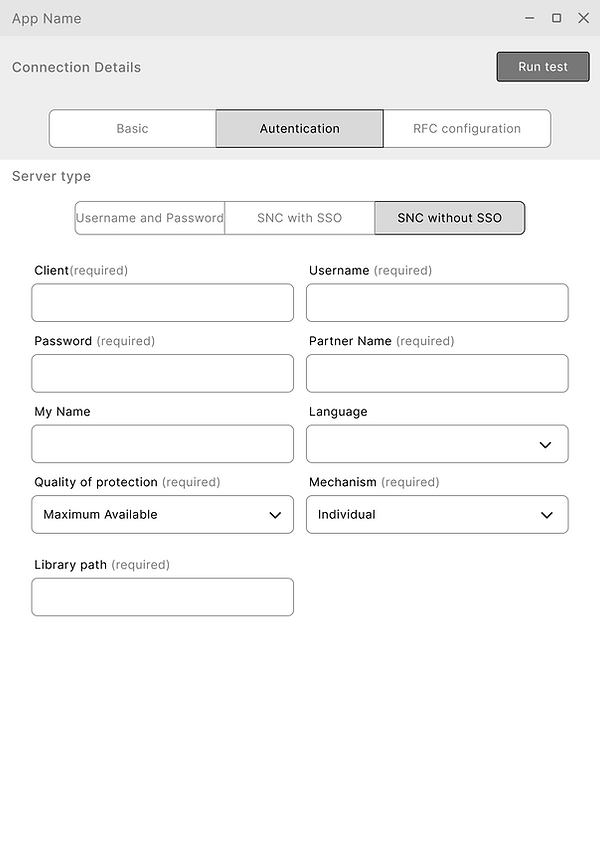Project Overview
Project: DAB Data Extraction Tool – UX Redesign
Company: DAB (Data Analytics & Business)
Role: UX Researcher & Designer
Timeline: 3 months
Objective: Improve the usability, clarity, and error handling of DAB’s internal data extraction tool to support both technical and non-technical users through a more guided and user-friendly experience
The Challenge
The primary challenge was designing a tool powerful enough for technical administrators but simple enough for analysts or business users. Since the app lacked visual guidance, smart validation, and progressive disclosure, users often:
-
Misconfigured inputs
-
Failed to authenticate
-
Struggled with interpreting results
There was no support for gradual onboarding or user-friendly error recovery.
My Process
I applied a human-centered design process, following the Double Diamond model: Discover → Define → Develop → Design → Deliver
Final prototype :



Discover Phase
To understand the problem and user pain points, I used a combination of qualitative and quantitative research:
5 stakeholder interviews
Interviewed 2 internal developers, 1 product owner, and 2 support engineers to understand system limitations and common user complaints. the insights were that: “Most users fail during the connection setup—not because the system fails, but because they don’t know what to enter.”
-
6 usability observation sessions
Observed 3 expert users and 3 non-technical users while they performed a full extraction flow.-
Non-technical users took 4–7 minutes longer to complete the form.
-
100% of novice users asked for help with terms like "RPC configuration" and "Auth Mode."
-
-
Support ticket analysis (last 3 months)
-
47% of tickets were about connection/authentication failures.
-
31% were about extraction jobs that “ran forever” with no visual progress or confirmation.
-
22% were about how to interpret the extraction progress page.
-
-
Heuristic Evaluation
-
Identified major UX violations in feedback, consistency, and error prevention.
-
Form did not support inline validation or field-specific help.
-
UI mixed advanced and basic options with no visual hierarchy.
-
Define Phase

User Journey Mapping
I mapped the end-to-end user journey to visualize touchpoints, emotions, and blockers across the workflow:
-
Start – Open the extraction tool (user feels neutral)
-
Step 1 – Enter connection details (confusion, fear of making a mistake)
-
Step 2 – Choose authentication type (overwhelmed by jargon)
-
Step 3 – Configure advanced options (uncertainty, trial and error)
-
Step 4 – Run the extraction job (unsure if it’s working)
-
Step 5 – Monitor progress (information overload, unclear indicators)
-
End – Receive result or error (relief or frustration depending on outcome)
Personas for distinct user groups :


Develop Phase
Here is the user flow of the redesign of the dab application :
1. Welcome
-
Screen: Welcome page with onboarding or intro message
-
Action: User clicks "Start" or "Begin Extraction"
2. Basic Info Input
-
Screens: Multiple basic data entry forms
-
Steps:
-
Enter target system or project info
-
Fill in metadata (e.g., name, ID, data type)
-
Continue to next section
-
3. Auto Configuration
-
Screens: Several configuration steps
-
Steps:
-
Set up connection parameters (host, protocol, port)
-
Choose authentication method (Username/Password, SSH, etc.)
-
Input credentials
-
Configure advanced options (RPC, filters, etc.)
-
Submit setup
-
4. RFC Check
-
Screens: RFC configuration and validation step
-
Purpose: Pre-validation before running the main job
-
Action: Confirm system compatibility or correct format
5. System Check
-
Screens: System check loading screens
-
Purpose: Backend tests connection, credentials, and form logic
-
Feedback:
-
Loading spinner or “checking…” status shown
-
6. Status Feedback
-
Screens:
-
Success screen (green)
-
Failure screen (red)
-
-
Outcome:
-
If success → user proceeds to data table
-
If failure → retry or fix input errors
-
7. Data Overview
-
Screens: Several versions of data tables
-
Steps:
-
Show list of extracted records
-
Indicate status, duration, errors (if any)
-
Provide filters and sorting
-
8. Final Screen
-
Screen: Confirmation or summary screen
-
Action: Download data or end the session
-
Optional: Restart extraction, view logs, or exit
Here is the user flow chart of the redesign of the dab application :

Design and Deliver Phase
wireframes of the dab application :



















Final prototype ( success flow ) :
UI KIT


